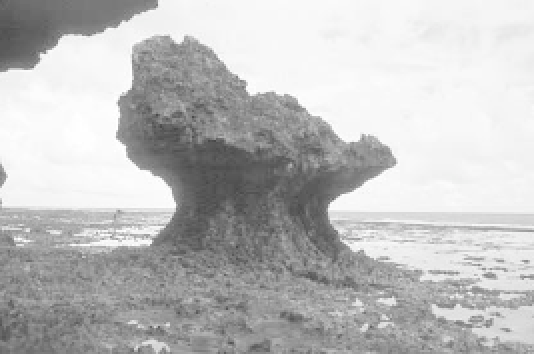Geology Reference
In-Depth Information
of calcium carbonate sediments (aragonite) to calcium-
magnesium carbonate rock (dolomite), the formation
of a terrace around the island, and the onset of chem-
ical weathering and the evolution of karst landforms,
particularly caves and karst holes. Similarly, Yoron-Jima,
a 21-km
2
carbonate island located in the central Ryukyu
Island Arc of southern Japan, was raised above sea level in
the Quaternary period. Subsequent karst processes have
produced many closed depressions (Terry 2005).
Closed depressions
Plate 8.7
A limestone solution notch on a modern shore
platform on the east coast of Okinawa, Japan.
(
Photograph by Derek C. Ford
)
Dolines
The word
doline
is derived from the Slovene word
dolina
,
meaning a depression in the landscape. It is applied to
the simpler forms of closed depressions in karst land-
scapes.
Sinkhole
,
swallet
, and
swallow hole
are English
terms with rather loose connotations. Dolines resem-
ble various shapes - dishes, bowls, cones, and cylinders.
They range in size from less than a metre wide and deep
to over hundreds of metres deep and several hundred
metres or even a kilometre wide. The large forms tend
to be complex and grade into other classes of closed
depressions.
Dolines are formed by several processes: surface solu-
tion, cave collapse, piping, subsidence, and stream
removal of superficial covers. Although these processes
frequently occur in combination and most dolines
are polygenetic, they serve as a basis for a five-fold
classification of dolines (Jennings 1985, 107; Ford and
Williams 1989, 398) (Figure 8.7):
Plate 8.8
Limestone coastal karren pitting (sometimes
called phytokarst or biokarst) on the west coast of
Puerto Rico.
(
Photograph by Derek C. Ford
)
1
Solution dolines
start where solution is concen-
trated around a favourable point such as joint inter-
sections. The solution lowers the bedrock surface, so
eating out a small depression (Figure 8.7a; Plate 8.9).
The depression traps water, encouraging more
solution and depression enlargement. Once begun,
doline formation is thus self-perpetuating. However,
insoluble residues and other debris may clog the
doline floor, sometimes forming swampy areas or
pools to form
pond dolines
. Dolines are one of the
few karst landforms that develop in soft limestones
such as chalk (e.g. Matthews
et al
. 2000).
wave action, wetting and drying, salt weathering, and
hydration.
Coral island karst
Carbonate sediments are the building material of the
world's coral islands, all of which bear at least some karst
features. For instance, Navassa Island, a 5-km
2
island in
the Caribbean Sea between Haiti and Jamaica, may have
started life as a small coral atoll. Some 5 million years ago,
these coral reefs began to emerge, leading the conversion


